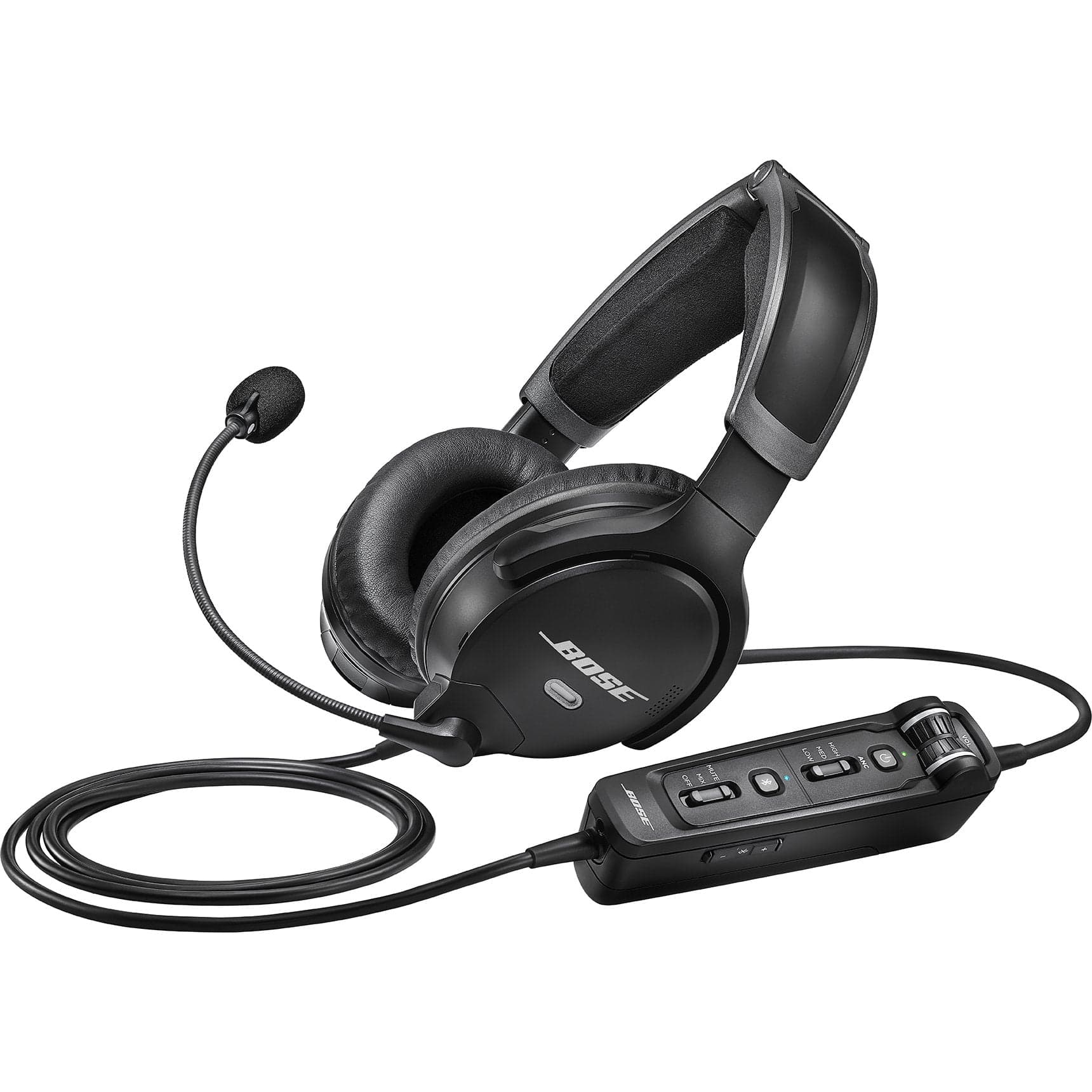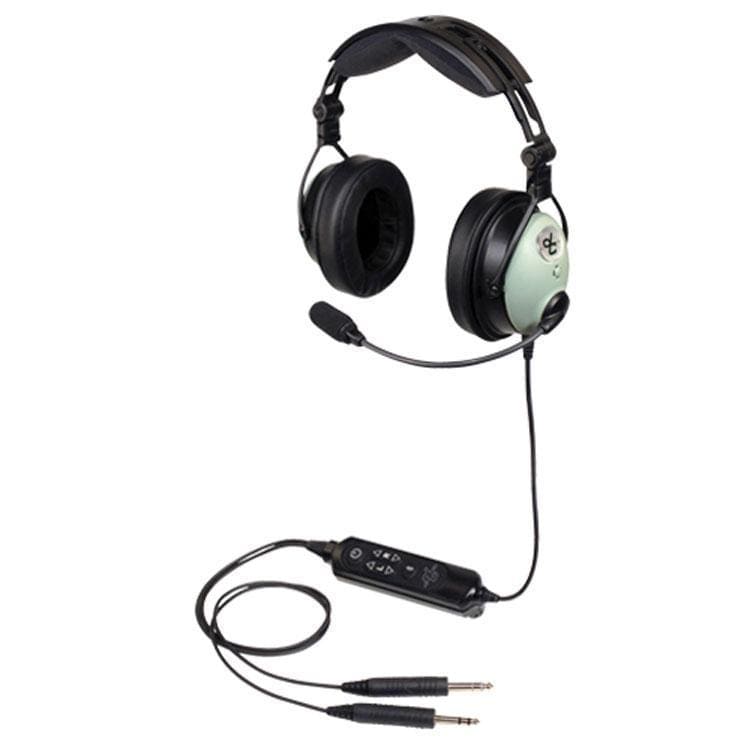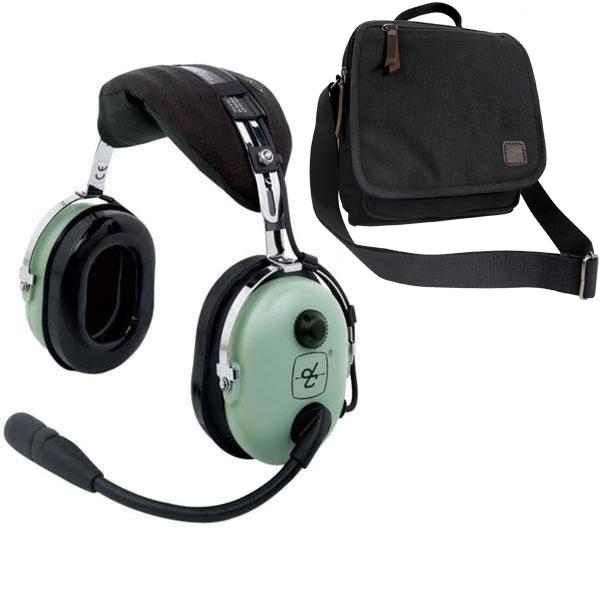 Shopping for pilot headsets can quickly become confusing, especially for the new or less technologically inclined pilot. There are so many factors to consider: on-ear vs over-ear headset, plug type, and active noise cancellation vs passive noise reduction, to name a few.
Shopping for pilot headsets can quickly become confusing, especially for the new or less technologically inclined pilot. There are so many factors to consider: on-ear vs over-ear headset, plug type, and active noise cancellation vs passive noise reduction, to name a few.
The good news is that plug type is determined for you based on your aircraft, and on-ear vs over-ear is a mainly a matter of personal preference. The variable that deserves some additional research and consideration is noise reduction type.
In this article we will explore the differences between noise reduction types, do a cost-benefit analysis of active noise reduction technology, and share some of our favorite active noise reduction headset models.
Table of Contents
- What is the Difference Between ANR and PNR?
- What is Passive Noise Reduction?
- What is Active Noise Reduction?
- How does ANR Work?
- What is Hybrid Noise Cancellation?
- What is Dynamic Noise Reduction?
- Is Active Noise Reduction Worth it?
- What to Look for in an ANR Pilot Headset
- What are the Best ANR Headsets for Pilots?
 What is the Difference Between ANR and PNR?
What is the Difference Between ANR and PNR?
Pilot headsets use several different types of noise reduction designs: active noise reduction (ANR), passive noise reduction (PNR), and dynamic noise reduction (DNR).
You may also see these technologies referred to as active noise cancellation (ANC), passive noise cancellation (PNC), and dynamic noise cancellation (DNC).
The important thing to know is that all pilot headsets reduce ambient noise and protect your hearing in some way. The difference between these headset types is the method they use to offset unwanted sounds, and the effectiveness of the noise reduction provided.
What is Passive Noise Reduction?
The most common and basic type of noise cancellation is achieved by physical means through passive noise-reduction.
Passive noise cancellation headsets use a physical barrier of padded, tightly fitted earcups to block out ambient noises. PNR/PNC designs do not require batteries and due to their simpler design, these headsets are priced lower than their ANR/ANC counterparts.
What is Active Noise Reduction?
Unlike passive noise reduction headsets which physically reduce noise by muffling it, active noise reduction headsets eliminate it nearly entirely. Active noise reduction is achieved through electrical means.
Instead of merely dampening noise, an ANR headset actively eliminates ambient sounds by generating an offsetting cancelling frequency. An ANR headset requires batteries to operate, and the sophisticated electronic technology involved correlates to a higher price point than the more basic passive noise reduction headsets.
 How does ANR Work?
How does ANR Work?
ANR headsets work by first picking up the sound waves of external noise sources through miniature earcup microphones. The headset then electronically produces a sound wave of the same amplitude but an inverted phase to that of the external noise source.
The generated inverted wave can be referred to as an “anti-noise” signal or phase flipping. Then the sound wave from the headset merges with the sound wave from the noise source, the result is an effective cancellation of the perceivable noise volume.
Most ANR headsets will reduce target noise by 10-20dB. It is worth noting than an over-ear ANR headset design will include a measure of passive noise reduction as well simply due to its design.
What is Hybrid Noise Cancellation?
Hybrid noise cancellation is an advanced variation of active noise cancellation. Most active noise cancellation headsets use a microphone either inside or outside the earcup to pick up the soundwaves from surrounding noise.
A feedforward ANR headset has an external microphone and does well with negating high-pitched noises but is less effective on lower frequencies. On the other hand, a feedback ANR headset uses an internal microphone that does well with low-end humming noises but does not completely eliminate sounds in the upper mid-range.
The difference with a hybrid ANR headset is that it uses both internal and external microphones. This allows a hybrid headset to offer a broader spectrum of noise cancellation.
What is Dynamic Noise Reduction?
The most advanced and least common pilot headsets are dynamic noise reduction (DNR) models. These headsets digitize signals in a numerical series then scans and removes any repetitive noise components of the signal.
DNR technology works on frequencies up to 3,500Hz. Expect to pay as much as $1,500 for a digital noise reduction headset.
Is Active Noise Reduction Worth it?
ANR headsets provide the very best in hearing protection for lower frequency noises below 1-2 kHz like aircraft engines, offering much better results than passive noise reduction headsets for this frequency range.
Active noise reduction headsets also allow pilots to listen to radio transmissions and music at a lower volume, unimpeded by external noise.
Since they block frequencies below 300Hz but allow you to hear other frequencies, ANR headsets provide hearing protection without the compromise of muffling other important sounds like cockpit alerts or the sputtering of an engine.
The potential downside of active noise reduction headsets is their higher price point compared to passive noise reduction headsets. That said, if well-cared for, ANR headsets have a long lifespan giving pilots many years-worth of quality hearing protection and auditory comfort.
When the price is averaged out across the lifespan of the headset, the yearly cost of an ANR headset investment is nominal.
Due to cost constraints, a new student pilot on a budget may elect to purchase a PNR headset initially and then upgrade to the ANR model later. Eventually, most pilots do opt for the enhanced performance provided by an ANR headset. Just remember to hang on to your retired PNR headset as it will work perfectly well for passengers.
What to Look for in an ANR Pilot Headset
Before you jump into shopping, ask yourself a few questions and make a list of the features that are important to you. Here are a few things to consider:
- Will you want a headset that has Bluetooth functionality?
- What earcup and headpad materials do you find most comfortable for long-term wear?
- What type of aircraft will you be using the headset in? Do you need more than one type of plug so your headset can work in both helicopters and GA fixed wing planes?
- Do you want to upgrade to dynamic noise reduction or stick with a standard ANR model?
- What is your preferred price range and what is your maximum price point?
What are the Best ANR Headsets for Pilots?
Now that you have a clear idea of what you are looking for, here are our choices for the best active noise reduction headsets for pilots:
1. Bose A20 Aviation Headset with Bluetooth
Bose’s legendary reputation in the audio world is well-earned, so it will come as no surprise that the Bose A20 tops our list of the very best ANR headsets.
This splurge-worthy model delivers both function and features in a seamless, comfortable, and stylish package.
Weighing in at just 12 ounces, the A20 nevertheless provides impressive overall electronic noise cancellation and a flex-boom, noise-cancelling electret mic.
The plush padded head pad and ear seals are comfortable for extended flights and a pair of AA batteries support over 40 hours of operation. Priority Switching, Bluetooth audio and cell phone connectivity round out the features of the Bose A20.
2. Bose ProFlight Series 2 Aviation Headset with Bluetooth

Another Bose offering, the ProFlight Series 2 is the deluxe aviation headset of choice for pilots who prefer an in-ear rather than on-ear style of ANR headset.
It holds the distinction of being the lightest, most compact, most comfortable aviation headset Bose has produced to date.
Engineered for professional pilots, the original ProFlight headset was then revised and refined based on pilot input to produce the Series 2. One of the highlights of the new model is a lighter, thinner, more flexible cable for increased freedom of movement and enhanced earbud tap control for talk-through communications.
At a mere 4.5 ounces, the ProFlight Series 2 is incredibly comfortable for extended use. Digital active noise cancellation technology protects your hearing while reducing ambient noise. All the extras are there including Bluetooth connectivity and audio prioritization.
3. David Clark Pro-X2 ENC Headset with Bluetooth
While ANR headsets may be pricier than their PNR counterparts, budget-friendly options like the David Clark Pro-X2 put active noise cancelling technology within reach of more pilots.
This over-ear model includes creature comforts like a heat-absorbing headband, swivel-hinge stirrup, an oblong dome, and plush leatherette earcups.
The hybrid electronic noise cancelling technology and automatic gain control (AGC) safeguards your hearing while ensuring you don’t miss any radio traffic in high-noise environments.
Your investment is protected with a legendary five-year warranty program and a 30-day money-back guarantee.
4. David Clark H10-13X ANR Headset
The H10-13X ANR headset is another shining example of David Clark’s ability to combine the ultimate in hearing protection, crystal clear communication quality, and unsurpassed comfort.
Even without utilizing the active noise reduction feature, the H10-13X provides a passive noise reduction rating of 23 dB. The ANR feature tacks on an additional 17-22 dB of targeted low-frequency electronic noise reduction.
An ultra-soft foam-filled pillow headpad and trademark undercut gel ear seals give the 18-ounce over-ear H10-13X headset unparalleled all-day comfort. This comfort is backed by a 25-hour battery life and auto shut-off feature.
5. David Clark One-X
The final David Clark ANR headset offering is the David Clark One-X. For pilots seeking the best technology, functionality, and connectivity, the DC One-X delivers.
This state-of-the-art headset brings you hybrid active noise cancellation technology and Bluetooth connectivity in a supremely comfortable package. The broad-spectrum noise cancellation protects your hearing while a vented heat pad keeps you cool during long haul flights.
As an added bonus, the five-year David Clark warranty provides generous customer service support and peace of mind.
6. Pilot USA PA-1761T ANR Headset
Pilots in the market for a cost-friendly ANR headset will appreciate the PA-1761T by Pilot USA. This headset combines conventional style with desirable features like cell and satellite phone capabilities and a proprietary Auto On/Auto Shut-off system.
Enjoy clear communications on all frequencies thanks to Enhanced Voice Intelligibility while your ears appreciate the physical comforts of silicone gel ear seals and a pillow top head pad.
7. Lightspeed Zulu 3 ANR Headset
The Zulu line of headsets is well-known for providing advanced features that pilots are looking for, and the Zulu 3 simply builds on that with added durability, comfort, and value.
In addition to the usual ANR headset offerings of auto shutoff and ComPriority, the Zulu 3 also comes loaded with Bluetooth functionality, auxiliary device input options, and the ability to capture and retrieve communications with the FlightLink app thanks to a supplied patch cable.
This headset is supported by a 30-day money back guarantee and 7-year limited warranty.
8. Faro G2 ANR Headset
The Faro G2 headset protects your hearing using feedback style ANR to offset low-frequency ambient aircraft noise throughout your flight.
Enjoy crisp, clear communications thanks to the noise-canceling electret mic and advanced dual volume control functionality.
An auxiliary cable is included for pairing your headset with your tablet, phone, or other digital devices. Purchase the G2 with confidence thanks to Faro's Full Coverage 3-Year Replacement Warranty.
9. Pilot USA PA-1779T ANR Headset
Rounding out our top ANR headset offerings is the Pilot USA PA-1779T. This unique headset holds the distinction of being built to closer tolerances with military components, offering additional active noise cancellation at 100Hz.
It is also the only self-contained ANR with a rechargeable NiMH battery and standard wall charger.
Join the ranks of members of the USA and Russian space programs who also use and enjoy the comfortable ANR headset complete with sheepskin fleece heat pad and the silicone gel ear seals.
Want to learn about the best ANR aviation headsets?
Check out these guides!
Did you find this article helpful?
Do you think we missed anything important? Let us know in the comments below!
















2 comments
Arthur
While I love ANR technology, the one drawback that I have found is you can’t hear what the airplane is doing, especially the engine. Many times, you will hear what the engine is doing before you can see it on a gauge (if you get an indication at all). I prefer passive noise reduction because it allows me to monitor all aspects of flying the airplane from engine noise, open doors and windows, cargo doors slapping in the slipstream, etc. while still allowing me to monitor the radios and other auditory indicators. For me, passive headsets help me with the safety of flight.
Phil DeRosier
OK, here’s the “deal” with ANR; while the noise *cancellation” is usually excellent, the noise *protection” to the ear continues to be “suspect.” An ANR set does not claim to be protective against physical damage. Therefore, if this is a concern, it has been suggested to use ear plugs while using an ANR set to mitigate the possible long term physical damage to the ear.
One more thing: there are some sounds a pilot should be hearing, like sounds an engine makes if it is about to fail.
ANR presents a problem not unlike polarized glasses when looking at some instruments on the panel – they black out when viewed at certain angles.